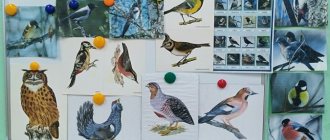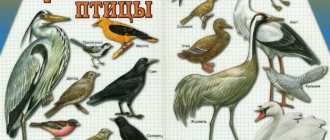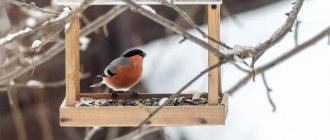Environmental project in the middle group “Help wintering birds”
Ecological project
in the middle group
"Help wintering birds"
Feed the birds in winter! Let flocks of people flock to your porch from all over, as if it were home. Teach the birds to your window in the cold, So that we don’t have to welcome spring without songs!
Relevance of the project
2017 in the Russian Federation by Decree of President V.V. Putin declared the year of ecology.
In modern conditions, the problem of environmental education of preschool children is of current importance. It is during the period of preschool childhood that the formation of personality and the formation of the beginnings of ecological culture take place. Environmental education is the education of morality and spirituality. On the one hand, preschool children are interested in living nature, but on the other hand they show cruelty and indifference. Therefore, it is very important to instill in children an interest and love for nature, and teach them to take care of the world around them.
And this work needs to begin with the environment closest to the child. Most modern children rarely communicate with nature. Birds surround us everywhere. Their importance in human life and in nature is very great. They destroy countless insects, maintaining the ecological balance in nature, and delight us with their singing. Birds have a difficult time in winter. They often go hungry. Many birds die during severe frosts. Tits, for example, lose up to 10% of their weight overnight at temperatures below -10.
But even in the most severe frosts, birds can survive if they have enough food. A particularly difficult time comes for birds at the end of winter, when almost all the food everywhere has been eaten. So the birds fly closer to people’s homes. The task of adults is to arouse children's interest in wintering birds, compassion, a desire to learn new facts from life, and teach them to help them.
Project technological map
| №/P | Content | Explanation |
| 1. | Project name | "Help wintering birds" |
| 2. | Project type | Information and educational |
| 3. | Project type | Group. |
| 4. | Duration | Short |
| 5. | Implementation time | From January 10 to February 20, 2017 |
| 6. | Project participants | Children of the middle group 4-5 years old, their parents, teachers. |
| 6. | Project organizers | Teachers: Stechkevich S.V., Lygina M.A. |
| 7. | Integration of educational areas | Cognitive, social and communicative, artistic and aesthetic, speech, physical. |
| 8. | Objective of the project | To form the foundations of ecological culture, ecological knowledge about wintering birds, caring attitude toward them, and the desire to help. |
| 9. | Tasks | - to form in children general ideas about birds as living beings that have a number of common external characteristics (wings, feathers, beak, two legs), but at the same time, differ from each other in their adaptation to certain climatic conditions and way of feeding; -expand children’s knowledge about wintering birds, - learn to observe specific objects: wintering birds of our region; -introduce interesting facts from the life of wintering birds; -involve children and parents in helping birds in winter; -develop children's creative abilities and interest in the life of birds; - to replenish the subject-development environment. |
| 10. | Expected results | -expanding children's horizons about wintering birds; -showing children's interest in objects of wildlife (wintering birds); — development in children of curiosity, cognitive activity, children’s compliance with the rules of behavior in nature, the ability to take care of birds; - nurturing compassion and love in children; - active participation of children and parents in helping birds; -increasing the competence of parents on issues of environmental education for children; |
Project stages
- PREPARATORY STAGE
- Discussion of goals and objectives with children and parents.
- Drawing up a work plan for project implementation.
- Drawing up a technological map of the project.
- Long-term project planning
- Selection of children's fiction.
- Development and accumulation of teaching materials on the topic.
2.MAIN (PRACTICAL) STAGE
I. Working with children
NGO "Cognitive Development"
Observations:
- looking for birds at the feeders;
- comparison of a dove and a sparrow;
- bird watching on the territory of the kindergarten;
- observation and comparison of bird tracks in the snow.
Didactic games:
- “Fold the bird” (cut pictures)
Target
: to form in children an idea of the holistic image of an object, teach them to fold a picture cut into four parts, teach them to recognize wintering birds by their characteristic features; develop logical thinking.
- “Guess the bird from the description”
Target:
clarify and consolidate children’s knowledge about the appearance of wintering birds, cultivate a caring attitude towards birds, and a desire to help them in winter.
- "Recognize by voice"
Target:
develop analytical hearing, expand children's knowledge about birds, and practice their ability to distinguish them by their voices.
- "Birds Menu"
Target:
to form children’s ideas about what wintering birds eat, what food is harmful to them, and to develop cognitive interest in the life of birds.
- "Count the Birds"
Goal: to consolidate the ability to coordinate quantitative adjectives with nouns.
- "Big small"
Goal: to consolidate children’s ability to form nouns and adjectives with diminutive meanings.
OOD Introduction to nature.
Topic: “How do birds live in winter?”
Target:
to form in children a generalized idea of wintering birds; basic knowledge of what they feed birds in winter; to teach children to take care of birds and watch them; develop cognitive interest in the life of wintering birds; cultivate a caring attitude towards birds, a desire to help them in difficult winter conditions.
NGO "Social and communicative development"
- Manual labor
Topic: “Edible feeder”
Target:
learn how to make edible bird feeder cookies, consolidate knowledge about food suitable for wintering birds. To form the beginning of an ecological worldview. Foster a desire to help birds survive the winter.
- Labor in nature
Topic: “Feeding the birds”
Target:
cultivate a caring attitude towards birds, a desire to help them in winter.
NGO "Artistic and Aesthetic Development"
OOD Drawing
- Topic: “Beautiful Bird”
Target
: teach children to draw a bird, conveying the shape of the body (oval), parts, beautiful plumage.
Practice drawing with pencils. Develop figurative perception and imagination. Cultivate interest in arts activities. T.S. Komarova “Art activities in kindergarten. Middle
group”
- Topic: “Beautiful Bird”
Target
: teach children to draw a bird, conveying the shape of the body (oval), parts, beautiful plumage. Practice drawing with pencils. Develop figurative perception and imagination. Cultivate interest in arts activities.
T.S. Komarova “Art activities in kindergarten. Middle group"
OOD Application
- Topic: “Sparrows are looking for food”
Target:
teach how to make images of a sparrow from parts, exercise children in cutting out rounded shapes from squares, in cutting a circle in a straight line, after folding it in half. To develop the ability to supplement the application with drawing elements. Develop thinking and fine motor skills of the hands. Cultivate sensitivity and responsiveness towards birds.
OOD Lepka
- Topic: “Sparrows at the feeder” (collective)
Target:
to develop children’s ability to sculpt birds in a constructive way from 4-5 parts of different shapes and sizes; develop a sense of form, ability to composition; cultivate an interest in nature and a desire to help wintering birds during the cold season
I.A. Lykova “Art activities in kindergarten. Middle group"
Storage system
- Design of the coloring book “Wintering Birds”
NGO "Physical Development"
- Outdoor games
- "Sparrows and the cat";
- "Sparrows and the car";
- "Migration of Birds";
- "Owl».
NGO "Speech Development"
- Speech communication:
- «
How do birds live in winter?”;
- "Birds Menu";
- “Who takes care of the birds?”;
- Problem situation: “What can happen if you don’t feed the birds in winter?”
- writing descriptive stories about birds using mnemonics.
- FICTION:
- M. Gorky “Sparrow”,
- Sukhomlinsky “What the titmouse is crying about”
- Guessing riddles, reading poems, discussing proverbs and sayings.
I I.Working with parents
- Consultations:
- Subject:
"Do-it-yourself bird feeders."
- Subject:
"Wintering Birds"
- Homework
- Make bird feeders;
- Prepare a presentation book “Wintering birds of our region”;
- Make a craft
3.FINAL STAGE
- Presentation of project results
- Campaign “Feed the birds in winter!”
- Exhibition of crafts and presentation books designed by parents
- Final lesson on cognitive development “How do birds live in winter?”
PROJECT PERFORMANCE
- Children's horizons about wintering birds have been expanded.
- The subject-development environment has been replenished with literature, illustrations, poems, and presentations about wintering birds.
- Children have developed curiosity and creative abilities.
- Children and parents took an active part in helping wintering birds.
- The competence of parents on environmental education issues has increased.
Application
“Feed the birds in winter!”
Feed the birds in winter! Let flocks of people flock to your porch from all over , as if it were home . Their food is not rich. They need a handful of grain, one handful - and they won’t be afraid of winter. It’s hard to count how many of them are dying. It’s hard to see. But in our heart there is also warmth for the birds... .
(A. Yashin)
In our middle group “Bees”, as part of the environmental project “Help Wintering Birds”, the “Bird Canteen” event was held. Parents responded and made bird feeders. Many thanks to them.
Many people, when feeding birds in winter, hang homemade feeders from various materials (boxes, plastic bottles). But few people think about what will happen to the feeders after winter. Some become limp and turn into trash, others hang on trees for several years, not making our parks and yards more attractive.
The guys and I studied the menu of wintering birds in our region and decided to make waste-free edible cookie feeders for them.
First, we prepared everything we needed: various food, molds, and gelatin. Then we mixed different types of feed and prepared gelatin.
Then there’s the “creative process of cookie formation.” We inserted a tube into the middle of each cookie-feeder and then thread a string into this hole. The cookies were taken to the refrigerator, and when they froze, they were hung on the site.
The birds liked our treat, and the next morning there was no trace of the feeders left.
Manual labor: “Edible feeder”





